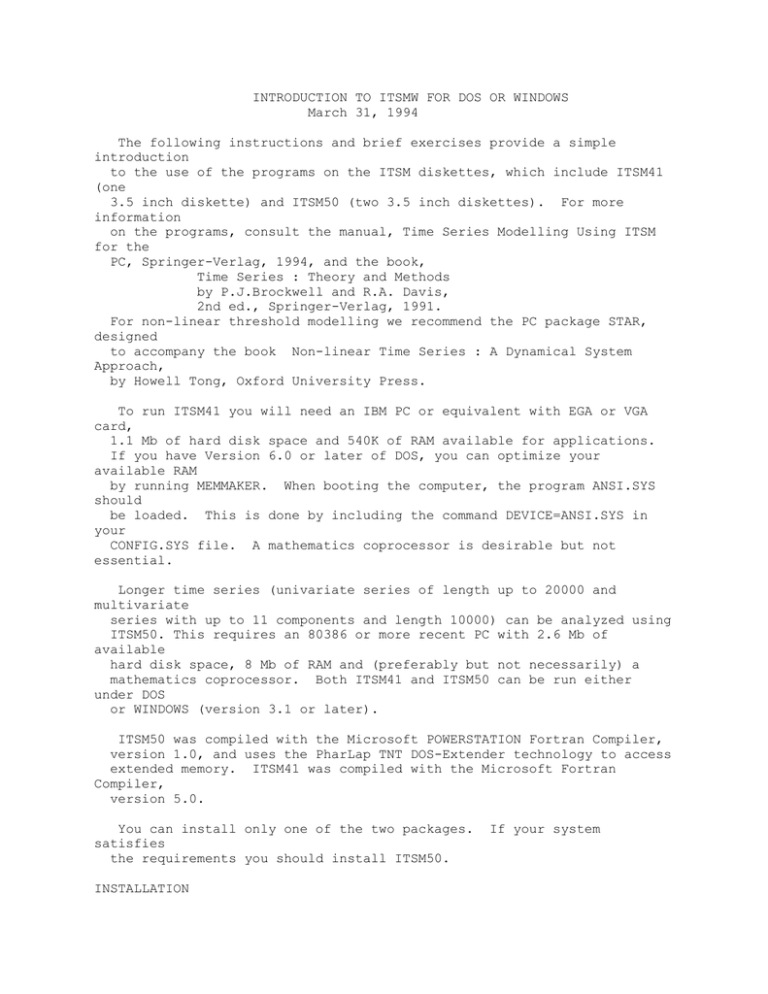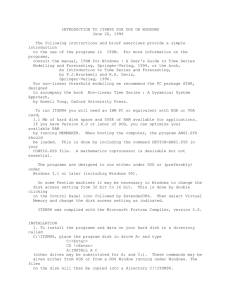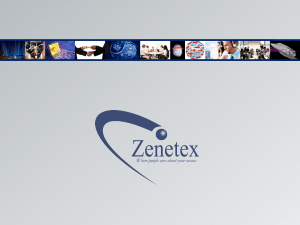INTRODUCTION TO ITSMW FOR DOS OR WINDOWS March 31, 1994
advertisement

INTRODUCTION TO ITSMW FOR DOS OR WINDOWS March 31, 1994 The following instructions and brief exercises provide a simple introduction to the use of the programs on the ITSM diskettes, which include ITSM41 (one 3.5 inch diskette) and ITSM50 (two 3.5 inch diskettes). For more information on the programs, consult the manual, Time Series Modelling Using ITSM for the PC, Springer-Verlag, 1994, and the book, Time Series : Theory and Methods by P.J.Brockwell and R.A. Davis, 2nd ed., Springer-Verlag, 1991. For non-linear threshold modelling we recommend the PC package STAR, designed to accompany the book Non-linear Time Series : A Dynamical System Approach, by Howell Tong, Oxford University Press. To run ITSM41 you will need an IBM PC or equivalent with EGA or VGA card, 1.1 Mb of hard disk space and 540K of RAM available for applications. If you have Version 6.0 or later of DOS, you can optimize your available RAM by running MEMMAKER. When booting the computer, the program ANSI.SYS should be loaded. This is done by including the command DEVICE=ANSI.SYS in your CONFIG.SYS file. A mathematics coprocessor is desirable but not essential. Longer time series (univariate series of length up to 20000 and multivariate series with up to 11 components and length 10000) can be analyzed using ITSM50. This requires an 80386 or more recent PC with 2.6 Mb of available hard disk space, 8 Mb of RAM and (preferably but not necessarily) a mathematics coprocessor. Both ITSM41 and ITSM50 can be run either under DOS or WINDOWS (version 3.1 or later). ITSM50 was compiled with the Microsoft POWERSTATION Fortran Compiler, version 1.0, and uses the PharLap TNT DOS-Extender technology to access extended memory. ITSM41 was compiled with the Microsoft Fortran Compiler, version 5.0. You can install only one of the two packages. satisfies the requirements you should install ITSM50. INSTALLATION If your system 1. To install the programs and data on your hard disk in a directory called C:\ITSMW, place the program disk (either ITSM50 or ITSM41) in drive A: and type C:<CR> A:UNZIP A:ITSMW<CR> (other drives may be substituted for A: and C:). The files on the disk will then be copied into a directory C:\ITSMW. (The decompression program UNZIP is supplied free of charge, courtesy of Info-ZIP, from whom the source code is also available.) 2. We shall assume now that you have installed ITSM as in 1 above and are in the directory C:\ITSMW. PRELIMINARIES FOR DOS OPERATION (IF YOU PLAN TO RUN THE PROGRAMS UNDER MICROSOFT WINDOWS GO TO 4 BELOW.) 3. Before running ITSM you will also need to load a graphics dump program if you wish to print hard copies of the graphs. This can be done as follows : (a) To print graphs on an HP LaserJet, LaserJet II or LaserJet III printer connected as lpt1:, type HPDUMP 1<CR> (b) To print graphs on an HP LaserJet, LaserJet II or LaserJet III printer connected as lpt2:, type HPDUMP 2<CR> (c) To print graphs on an Epson dot matrix printer connected as lpt1: type EPSDUMP<CR> (d) To save graphs in a disk file FNAME first execute either a or c above and then type LPTX -o FNAME -1<CR> Subsequent output directed to lpt1: is then stored cumulatively in the file FNAME. [To switch off this option, type LPTX -c<CR>] NOTES: If in steps a, b or c you get the message 'highres already loaded' it means that one of hpdump 1, hpdump 2 or epsdump has already been loaded and you will need to reboot the computer if you wish to load a different one. If you have an HP LaserJet III printer with 1 Mbyte or more of optional memory installed, it is essential to set Page Protection on the printer to the appropriate page size or you will get the error message, 21 PRINT OVERRUN, and the bottom of the printed graph will be cut off. See the LaserJet III Printer User's Manual, p. 4.25. 4. If you wish to run the programs under Microsoft Windows you will first need to carry out the following steps: (a) Type C:\ITSMW\INVSCRN <CR> This loads the program INVSCRN which will be used for printing graphs and other screen displays. It is convenient to bypass this step by adding the line C:\ITSMW\INVSCRN to your autoexec.bat file. This can be done by typing WORD6 C:\AUTOEXEC.BAT <CR> inserting the required line and then saving the new file by holding down the <Alt> key while typing W then typing <CR>. To exit from WORD6 hold down the <Alt> key and type X. The program INVSCRN will then be automatically loaded each time you boot your computer. (If you have installed ITSM5, you must also add the line DEVICE=C:\ITSMW\DOSXNT.386 immediately below the line [386Enh] of the SYSTEM.INI file in the directory C:\WINDOWS. Do this by typing WORD6 C:\WINDOWS\SYSTEM.INI <CR> and proceeding as above.) (b) Type COPY C:\ITSMW\ITSMWIN.REC C:\WINDOWS <CR> Type COPY C:\ITSMW\*.ICO C:\WINDOWS <CR> (c) Run Windows by typing WIN <CR> (d) Double click on the RECORDER icon in the ACCESSORIES window (e) Click on FILE in the RECORDER window (f) Click on the option OPEN (g) Click on the file name ITSMWIN.REC (h) Click on OK (i) Click on MACRO in the RECORDER window (j) Click on RUN You should now see a window labelled itsmw containing icons for the ITSM modules PEST, SMOOTH, etc. and the screen editor WORD6. To run any one of them, e.g. WORD6, double click on the appropriate icon. To exit from the screen editor WORD6, hold down the <Alt> key and press X. To terminate the RECORDER session click on the icon RECORDERITSMWIN.REC then click on CLOSE. IN CASE OF DIFFICULTY running ITSMWIN.REC the Windows installation can be done manually as described at the end of this document. You may wish to resize and relocate the itsmw window. Once you have done this, you can save the Window display as follows. Click on OPTIONS in the PROGRAM MANAGER window and click on the SAVE SETTINGS ON EXIT option so that a check appears beside it. Then exit from Windows. When you next run Windows by typing WIN you will see the same arrangement of windows, including the itsmw window set up previously. To prevent inadvertently changing this arrangement when you next exit from Windows, click again on OPTIONS in the PROGRAM MANAGER window and then click on the SAVE SETTINGS ON EXIT option to remove the check mark. RUNNING ITSM 5. You are now ready to run ITSM (assuming you have completed steps 3 or 4). If you are running the programs in DOS, change the directory to ITSMW by typing CD \ITSMW<CR> Make sure the <Num Lock> key is off, type ITSM<CR> and select a module (e.g. SMOOTH) from the ITSM menu by highlighting your selection with the arrow keys and pressing <CR>. (If you have an activated mouse, the mouse pointer must be clear of the menu choices before you can use the arrow keys. Depending on your mouse driver, you may be able to use your mouse for menu selection. In case of problems with the mouse, you should deactivate it or move the pointer clear of the screen and use the arrow keys.) If you are running the programs in Windows, double click with the mouse on one of the icons (e.g. SMOOTH) located in the itsmw window. When you see the module title enclosed in a box on the screen, press any key to continue, selecting items from the menus as they appear. After exiting from the module SMOOTH you can exit from ITSM by pressing <F10>. PRINTING GRAPHS 6. DOS : Assuming you have carried out the appropriate steps described in 3, screen displays (text or graphic) can be printed (or filed) by pressing <Shift> <Prt Scr> when you see the required image on the screen. If you chose to file graphics output in FNAME, you can print the stored graphs after exiting from ITSM by typing, e.g., COPY /B FNAME LPT2: (assuming you chose 3a and 3d above and now have an HP Laserjet printer connected as lpt2:) or COPY FNAME LPT2: (if you chose 3c and 3d above and now have an Epson dot matrix printer connected as lpt2:). WINDOWS : To print any screen display from ITSM, make sure you are operating in full screen mode (by holding down the <Alt> key and pressing <Enter> if necessary). Then hold down the <Shift> key and press <Print Scrn>. Provided you have loaded the program INVSCRN as described in step 4(a) above, this will cause the screen image to be inverted to black on white. Then press the <Print Scrn> key and the displayed text or graph will be copied to the CLIPBOARD. You can transfer it to a document in (for example) Microsoft Write using the commands EDIT then PASTE. The document containing the graph can be printed on whatever printer you have set up to operate under WINDOWS by using the commands FILE and PRINT in Microsoft Write. To switch between applications in Windows (such as ITSM and Microsoft Write), hold down the <Alt> key and press <Tab>. EXAMPLE 1 CREATING A DATA SET. In DOS type WORD6<CR> to call the screen editor WORD6, or in Windows double click on the WORD6 icon. Type 1<CR> 2<CR> 3<CR> 4<CR> 5<CR> Next hold down the <Alt> key and press W. You will be asked for a filename. Type TEST.DAT<CR>. The column of numbers 1 2 3 4 5 will then be filed under the name TEST.DAT. (Data file names should all end with .DAT) To leave WORD6, hold down the <Alt> key again and press X. To read the new file, call WORD6 again as described above. Hold down the <Alt> key and press R. You will be asked for a filename. Type TEST.DAT<CR>. Your new datafile consisting of the column of numbers 1 2 3 4 5 will then be read into WORD6 and printed on the screen. (In DOS you can alternatively type the instruction WORD6 TEST.DAT<CR> to read the file TEST.DAT) If there is a printer connected to your computer as LPT1: you can print the file in WORD6 at any time by holding down the <Alt> key and pressing W, then giving LPT1 as the name of the file to be written. For further information on the use of WORD6, see the ITSM manual, Appendix A, or in WORD6 press <F1>. EXAMPLE 2 USING ITSM TO SMOOTH THE STRIKES DATA. In DOS run ITSM, use the arrow keys or mouse to highlight the module SMOOTH and press <CR>. In Windows double click on the SMOOTH icon. When you see the boxed title, PROGRAM SMOOTH, press <CR> and follow the prompts provided by the program, selecting options and data from the menus as they appear. These should be selfexplanatory. Not all the data files are visible in the data display box simultaneously.To access the others, use the arrow keys to scroll up or down (after making sure that the mouse pointer (if activated) is outside the data display box). Do not use the filename STRIKES.DAT to store the smoothed data produced by the program or it will attempt to overwrite the original datafile with that name. When selecting data files using ITSM50, you must first move the highlight bar to the subdirectory <DATA> and press <CR>. You will then see the data files listed and can make your selection as described above. EXAMPLE 3 USING PEST TO PLOT THE DEATHS DATA. Select the module PEST in the same way we selected SMOOTH in Example 2. When you see the boxed title, PROGRAM PEST, press <CR> or click with the mouse and you will see the PEST menu. Choose the first option and you will then see a smaller menu. Choose the first option again. Choose YES and you will be asked to select a dataset. Use the arrow keys to highlight the file name DEATHS.DAT in the data display box and then type <CR>. The program will then read the contents of the file DEATHS.DAT and give you another menu. This time choose the second option to plot the data. A histogram of the datafile DEATHS will appear on the screen. If your computer is connected to a suitable printer this can be printed as described above. To continue with the program, type <CR> and a graph of DEATHS vs time will appear on the screen. (This can be printed in the same way.) Typing <CR> and selecting the option Return will return you to the data menu. Then choose the last option to return to the main menu and the last option of the main menu to exit from PEST. If you are running in DOS press press <F10> to exit from the ITSM menu. EXAMPLE 4 USING THE MODULE PEST TO DO PROBLEM 1.8. Proceed as in EXAMPLE 3 to read in the datafile DEATHS.DAT. Plot the data as before, type <CR> and choose the Return option to return to the data menu. Choose option 6 for classical decomposition and type 12<CR> to specify the period. The seasonal components will then appear on the screen. They can be printed as described above. Type <CR> to return to the data menu. At this stage the data has been deseasonalized by subtraction of the seasonal components. Use option 7 to fit a quadratic trend y(i)=a(0)+ia(1)+i^2a(2), i=1,...,72. Type <CR> to return to the data menu. The data has now been deseasonalized and detrended. Use option 2 of the data menu to plot the residuals and option 3 to plot their sample autocorrelation function. [MANUAL SETUP FOR OPERATION UNDER WINDOWS If you had trouble running the setup procedure in Step 4 above,here is an alternative but less streamlined procedure to replace it: (a) Load INVSCRN and (if you are installing ITSM50) add the required line to your SYSTEM.INI file as described in 4(a) above (b) Copy the files as in 4(b) and run Windows by typing WIN<CR> (c) Click on FILE in the PROGRAM MANAGER window (d) Click on the option NEW (e) Click on PROGRAM GROUP (f) Click on OK (g) After the heading DESCRIPTION type ITSMW (h) Click on OK At this point a window will open with the heading ITSMW. (i) Click again on FILE in the PROGRAM MANAGER window (j) (k) (l) (m) (n) Click on NEW Click on PROGRAM ITEM Click on OK After the heading DESCRIPTION type pest After the heading COMMAND LINE type c:\itsmw\pest.pif (Replace pif by exe for ITSM41) (o) After the heading WORKING DIRECTORY type c:\itsmw (p) Click on CHANGE ICON (q) Click on OK (r) Type pest.ico (s) Click on OK (t) Click on OK (u) Click on OK The itsmw window will now contain an icon labelled pest. To run pest, double click on this icon and the pest menu will appear on the screen. Repeat steps (i)-(u), replacing pest in (m), (n) and (r) by smooth. second icon will then appear in the itsmw window, labelled smooth. A Repeat steps (i)-(u) for each of the other modules, spec, trans, arvec, burg, arar, longmem and word6, in each case replacing pest in (m), (n) and (r) by the appropriate module name. You should then have nine icons in the itsmw window. Each module is run by double clicking on the appropriate icon. To exit from the screen editor word6 hold down the <Alt> key and press X. It is usually advantageous, especially when saving or printing graphs, to run ITSM in full-screen mode. Holding down the <Alt> key and pressing <Enter> toggles ITSM between full-screen and window modes. To save the Window display, click on OPTIONS in the PROGRAM MANAGER window and click on the SAVE SETTINGS ON EXIT option so that a check appears beside it. Then exit from Windows. When you again run Windows by typing WIN you will see the same arrangement of windows, including the ITSMW window set up previously. To prevent inadvertently changing this arrangement when you next exit from Windows, click on the SAVE SETTINGS ON EXIT option again to remove the check mark.] NOTE. If after installation you select a module and nothing happens, it is very likely that you do not have sufficient RAM available for applications. To run the ITSM41 programs under Windows you will need 537K of available RAM. To run ITSM41 under DOS you will need 548K, however the modules can also be run directly from DOS (by typing PEST<CR>, SMOOTH<CR>, etc. instead of ITSM<CR>) in which case 537K of RAM will suffice. If you have DOS 6.0 or later you can optimize your available RAM using MEMMAKER.


